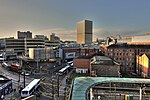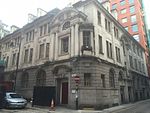Market Street, Manchester
Pedestrian streets in the United KingdomShopping streets in ManchesterStreets in ManchesterTourist attractions in ManchesterUse British English from November 2017

Market Street is one of the principal retail streets in Manchester, England. It runs from its junction with Piccadilly and Mosley Street, close to Piccadilly Gardens, in the east to where it meets St. Mary's Gate at the crossroads with Exchange Street and New Cathedral Street in the west. St Mary's Gate then continues to where it meets Deansgate (A56). Other major streets crossed are High Street, Corporation Street (on the north side), Cross Street and Fountain Street (on the south side).
Excerpt from the Wikipedia article Market Street, Manchester (License: CC BY-SA 3.0, Authors, Images).Market Street, Manchester
Market Street, Manchester City Centre
Geographical coordinates (GPS) Address Nearby Places Show on map
Geographical coordinates (GPS)
| Latitude | Longitude |
|---|---|
| N 53.482361111111 ° | E -2.2405555555556 ° |
Address
Market Street
Market Street
M1 1PN Manchester, City Centre
England, United Kingdom
Open on Google Maps










